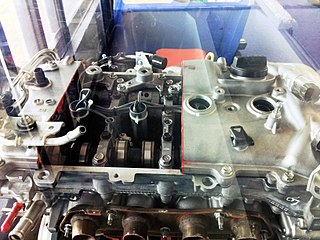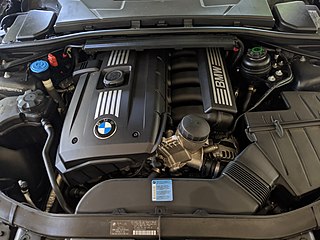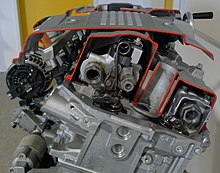
A camshaft is a shaft that contains a row of pointed cams in order to convert rotational motion to reciprocating motion. Camshafts are used in piston engines, mechanically controlled ignition systems and early electric motor speed controllers.

VTEC is a system developed by Honda to improve the volumetric efficiency of a four-stroke internal combustion engine, resulting in higher performance at high RPM, and lower fuel consumption at low RPM. The VTEC system uses two camshaft profiles and hydraulically selects between profiles. It was invented by Honda engineer Ikuo Kajitani. It is distinctly different from standard VVT systems which change only the valve timings and do not change the camshaft profile or valve lift in any way.

Variable valve timing (VVT) is the process of altering the timing of a valve lift event in an internal combustion engine, and is often used to improve performance, fuel economy or emissions. It is increasingly being used in combination with variable valve lift systems. There are many ways in which this can be achieved, ranging from mechanical devices to electro-hydraulic and camless systems. Increasingly strict emissions regulations are causing many automotive manufacturers to use VVT systems.

VVT-i, or Variable Valve Timing with intelligence, is an automobile variable valve timing petrol engine technology manufactured by Toyota Group and used by brands Groupe PSA, Toyota, Lexus, Scion, Daihatsu, Subaru, Aston Martin, Pontiac and Lotus Cars. It was introduced in 1995 with the 2JZ-GE engine found in the JZS155 Toyota Crown and Crown Majesta.

VANOS is a variable valve timing system used by BMW on various automotive petrol engines since 1992. The name is an abbreviation of the German words for variable camshaft timing.

MIVEC (Mitsubishi Innovative Valve timing Electronic Control system) is the brand name of a variable valve timing (VVT) engine technology developed by Mitsubishi Motors. MIVEC, as with other similar systems, varies the timing of the intake and exhaust camshafts which increases the power and torque output over a broad engine speed range while also being able to help spool a turbocharger more quickly and accurately.
The GM Ecotec engine, also known by its codename L850, is a family of all-aluminium inline-four engines, displacing between 1.2 and 2.5 litres. Confusingly, the Ecotec name was also applied to both the Buick V6 Engine when used in Holden Vehicles, as well as the final DOHC derivatives of the previous GM Family II engine; the architecture was substantially re-engineered for this new Ecotec application produced since 2000. This engine family replaced the GM Family II engine, the GM 122 engine, the Saab H engine, and the Quad 4 engine. It is manufactured in multiple locations, to include Spring Hill Manufacturing, in Spring Hill, Tennessee, with engine blocks and cylinder heads cast at Saginaw Metal Casting Operations in Saginaw, Michigan.

The BMW M50 is a straight-6 DOHC petrol engine which was produced from 1990 to 1996. It was released in the E34 520i and 525i, to replace the M20 engine.

The BMW M52 is a straight-6 DOHC petrol engine which was produced from 1994 to 2000. It was released in the E36 320i, to replace the M50. The BMW S52 engine is a high performance variant of the M52 which powered the American and Canadian market E36 M3 from 1996 to 1999.

BMW M62 is a naturally aspirated V8 petrol engine which was produced from 1995 to 2005. A successor to the BMW M60, the M62 features an aluminium engine block and a single row timing chain.
The BMW N42 is a DOHC four-cylinder petrol engine which replaced the BMW M43 and was produced from 2001-2004.

The BMW N62 is a naturally aspirated V8 petrol engine which was used in BMW cars from 2001 to 2010. It also remained in small-scale production for the Morgan Aero until 2019. The N62 is the world's first engine to use a continuously variable-length intake manifold, and BMW's first V8 to feature variable valve lift.

Prince is the codename for a family of straight-four 16-valve all-aluminium gasoline engines with variable valve lift and variable valve timing developed by BMW and PSA Peugeot Citroën. It is a compact engine family of 1.4–1.6 L in displacement and includes most modern features such as gasoline direct injection and turbocharger.

A valvetrain is a mechanical system that controls the operation of the intake and exhaust valves in an internal combustion engine. The intake valves control the flow of air/fuel mixture into the combustion chamber, while the exhaust valves control the flow of spent exhaust gases out of the combustion chamber once combustion is completed.
The BMW N45 is a naturally aspirated four-cylinder petrol engine which replaced the BMW N40 and was produced from 2004-2011. It was produced alongside the BMW N46 engine and only sold in some countries, where vehicle taxes favoured small-displacement engines.

The BMW N52 is a naturally aspirated straight-6 petrol engine which was produced from 2004 to 2015. The N52 replaced the BMW M54 and debuted on the E90 3 Series and E63 6 Series.

The BMW N73 is a naturally aspirated V12 petrol engine which replaced the BMW M73 and was produced from 2003–2016. It was used in the BMW 7 Series (E65) and Rolls-Royce Phantom VII.

Nissan Variable Valve Event and Lift is an automobile variable valve timing technology developed by Nissan.

MultiAir or Multiair is a hydraulically-actuated variable valve timing (VVT) and variable valve lift (VVL) engine technology enabling "cylinder by cylinder, stroke by stroke" control of intake air directly via a gasoline engine's inlet valves. Developed by Fiat Powertrain Technologies, the technology addresses a primary engine inefficiency: pumping losses caused by restricting intake passage by the throttle plate that regulates air feeding the cylinders.
Variable valve lift (VVL) is an automotive piston engine technology which varies the height a valve opens in order to improve performance, fuel economy or emissions. There are two main types of VVL: discrete, which employs fixed valve lift amounts, and continuous, which is able to vary the amount of lift. Continuous valve lift systems typically allow for the elimination of the throttle.
















